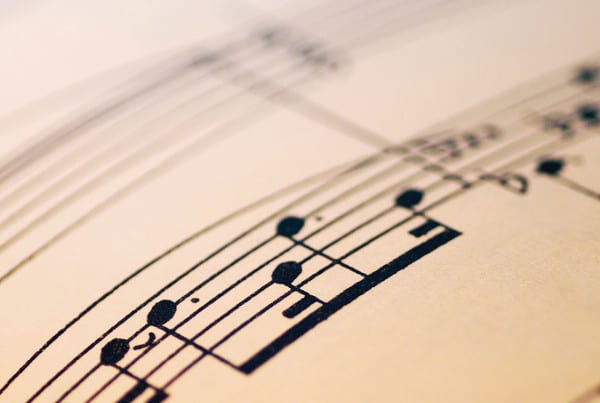In dance music you’ll often hear references to “Strict Tempo.” Strict tempo refers to much more than just the speed of the music, but we’ll start there because that’s an obvious difference.
Music recorded for listening entertainment, such as chart hits, are built for their artistic qualities. The tempo is determined by the emotional impact the artists are trying to achieve. This means that a 4/4 song can have a huge range of “bars per minute” (BPM, which is the usual way we refer to the speed of dance music).
A slow Latin love song may have one bar (four beats) happening 20 times per minute, and another equally emotional love song may have a faster rhythm that measures more than 40 bars per minute. Naturally that kind of range becomes a challenge for dancers! Since dances require the beat count to fit within certain parameters to work properly, not all popular music — even if it has the right kind of beat — will work for dancing. Some songs are simply too fast or too slow.
Whatever tempo a song is created at, it will usually stay fairly true to that tempo from start to finish. Whether it measures exactly 32 bars per minute or 32.5 doesn’t really matter much, even for competition purposes. The song is unlikely to vary from 32 up to 32.5 and back again. It will stay at the beat count it started with. So what’s the problem? Can’t we just pick songs that have the speed we want? The answer is a bit more complicated.
One challenge is that artists write their music not with dancing in mind but with their artistic goal in mind. They might suddenly stop the music entirely part way into the song to achieve an objective.
However, that kind of variation is actually quite rare and not really what “strict tempo” is all about, though it is part of it.
Strict Tempo in Action
Given the choice, which version of Julio Iglesias’ “Hey” would you use for a dance lesson or competition: The chart hit people have grown to love, or the strict-tempo version from Dancelife?
Strict-tempo versions of songs contain subtle differences that often make them a better choice for dancing. Minor improvements to how the instruments are used help dancers find points in the beat for things like shifting their body weight or splitting the beat. Plus, the balance of vocals to instruments is usually optimized in strict-tempo songs.
For casual parties or show dancing, you can use the original chart hit any time. In the case of the song “Hey,” the original chart hit is a little soft on the actual beats. The attention is on Julio’s incredible vocals. Because the instruments are slightly mushy the strict tempo version is more suitable for serious dance events, as it more clearly identifies the beat count for dancers, allowing them to use the music more effectively in their presentation.
The real differences
The more thorny problem with popular music is the artistic license taken with how the beat is handled and how the instruments and vocals are paced within the beat count. A number of issues affect how “danceable” a song really is, regardless of whether the beat count falls within desired speed ranges.
Phrasing.
Strict-tempo music is designed so that dancers have phrasing that they can rely on. You’ll notice, for example, that a strict-tempo Samba score will subtly rise in scale for 4 bars, then come down for the nextt 4. This means your movements can go up during the first 4 bars and downwards for the next 4, giving your choreography a much more pleasing look. Viennese Waltz is phrased to rise for 7 bars, reach a crescendo on the 8th, then come down and start again. Slow Foxtrot music consists of 4 phrases of 8 beats each that gradually rise in pitch, then it starts over again. This empowers experienced dancers to use those changes to create interesting choreography, even on the fly.
Song intros.
Some pop hits include creative introductory sections that may run several bars. These might involve acapella vocals or sound effects. Obviously that becomes a challenge if you’re trying to get people on the dance floor and they don’t even know what kind of dance the song is for! Strict tempo versions of the same song will remove those introductory bars.
Unexpected pauses.
I’ve already mentioned the sudden changes in the beat that can happen well into the song, anything ranging from pauses to split beat counts to wildly changing instruments. Creatively it might be a great thing that helps the artist express the meaning of the song, but for dancing such changes cause huge problems for all but the most experienced dancers. Those are taken out when the same song is covered for strict tempo. I’ve run across Samba music that has the expected 8-beat phrasing, and suddenly there’s a 4 or even 6-beat phrase, making it very challenging if you have pre-planned choreography.
Musical cues.
A song written for the pop charts doesn’t care much about how people might dance to it. So it won’t contain musical cues especially designed to help dancers. Strict tempo music is designed especially for dancing. It holds a true beat count, keeps the tempo manageable (though some strict tempo songs still provide plenty of challenging moments), and offers subtle additional treatment that helps give the dancers cues for syncopation or opportunities for splitting the beat. If you listen carefully, you’ll begin to hear extra instruments that provide aural cues for the dancer, especially in the Latin music.
What about music for social dance parties?
Strict tempo music is pretty much essential for dance lessons, performances or competition. For casual parties or practice, popular chart hits rarely present a problem. Often it’s actually better to use the original hit because some people may wonder who that stranger is singing one of their favorite songs that they’ve grown to love.
Some chart hits are even used very effectively at dance competitions. However, only an experienced ear can determine whether a chart hit will be suitable for serious dancing situations. There are many issues related to how well the musical character of each song captures the essence of the dance. This site attempts to provide details to help you make an informed decision, but as a general rule you should go with the strict tempo version unless you’re really sure about what you’re doing.














Thank you for this excellent, concise and full explanation of strict-tempo. I am not a dancer (wish I was, just that the opportunity has not arisen) but I am a record collector. I have been enjoying the work of Victor Silvester, and wanted to know what was this thing, strict tempo, for which he was famed. And now I know: thanks for sharing.
I thought “BPM” stood for Beats Per Minute, not “bars”.
Yes, in the music industry BPM stands for “beats per minute.” The number is much higher. You might see a BPM of 120 or 150. In the dance world, BPM stands for “bars per minute” so the numbers are much smaller like 29 or 30 or 40 etc.
Hello!
Thank you for your essay on Strict Tempo, which I shall be recommending to a great many people. Could you please give me examples of songs that are `too fast or too slow to dance to` (one of each would be good) just so that I can demonstrate your point more clearly to them?
MP X
I appreciate the interest in this topic. I’d love to provide you with information on which songs don’t meet danceable tempi but it’s not something I keep track of. If a piece of “dance” music can’t be reasonably danced to, I banish it. So I don’t even have a record of songs that don’t work.
You can use a tempo measuring app like “Turnover” to measure the tempo of a song. These apps let you click or tap to each beat and then displays the tempo of the music. Using one of those apps you can experiment with different pieces of music. But you might be able to find some that show the tempo in the description (iTunes music often does have this info) and use that as a guide.
Where I have found this issue to be most troublesome is when so-called “Dance” bands play music that can’t be danced to. It happens a lot. These bands have never invested any energy into what dancers need, so they assume anything called a Waltz must be Waltz music. I have approached band leaders a few times and pointed out that all of their Slow Waltzes were way too fast to dance too. The usual response is to shrug and say “That’s the speed we play them.” If you find a dance band that gets this and is committed to doing it right, they are a gem.
Hi, George.
Just come across this page of info by you – very comprehensive, and from someone who`s BeenThere and Done That! Could you just explain the following, please. I`ve tried to work out what you mean but not sure: Is it `Ballroom has 12 bars IN a phrase and Sequence 16 bars IN a phrase?` Thanks.
“The difference between Ballroom and Sequence is in the amount of bars – sequence has 16 bars phrased and ballroom 12.”
I’m not sure where you got that text “Ballroom has 12 bars IN a phrase and Sequence 16 bars IN a phrase.” As I said in the article, ballroom and latin music has different numbers of beats in a phrase depending on which dance. Samba music is in 2/4 time and thus has 2 beats in one bar and 8 beats in a phrase. Viennese Waltz is 6/8 time and has 3 beats in a bar, with 24 beats making up a typical group of phrases. Slow Foxtrot has 4 beats in a bar of music and 8 beats in a phrase, with 32 beats making up a typical group of phrases. I don’t know anything about Sequence dancing so I can’t comment on that, but I can’t see how it would change the phrasing since that’s in the music, not the dance.
Thank you, George, and I must immediately apologise because (as you know!) it wasn`t a quote from your article at all. I saved your text a while back – but then added other material to the page , and mistakenly sent you a quote from THAT. Sorree.
However, I`m startled that you say Viennese Waltz is in 6/8 and has THREE beats in a bar, which is not the case. 3/4 – ie three crotchets per bar – is commonly the time sig for a V Waltz, heard as triple time, and at 60bpm. 6/8 is an example of Compound Time, ie, two DOTTED crotchet beats per bar, and is heard as duple time. Mind you, if the dotted crotchets are divided into quavers, there are 6 notes in a bar (2×3) so one could conceivably dance to it if it was the right tempo. You`d just dance 1-2-3 TWICE in each bar! I`m not sure if you can give me an example of a VW like that in 6/8, and I`ve never played, conducted or seen one.
You are correct, Ian. When I first learned to dance I was always taught that Viennese Waltz was in 6/8 timing. In recent years, that has changed and now it is rare to find such a reference although it does still appear in some teaching materials. This always confused me a bit but I just learned to accept it as fact. I believe the reason was because there are 6 steps in a complete rotation and this was used to manage the phrasing. I was always taught to dance it as “123456, 223456, 323456, 423456, 523456, 623456, 723456” and then on the “823456” we would create something dramatically different to take advantage of the new phrasing sequence. For example, I might create a Contra Check. I’m a dancer, not a musician, so my understanding of music is not very sophisticated except in terms of how it relates to dancing.
Ah, thank you, George, that is very interesting, and now makes perfect sense – in dancers` terms, which, as you suggest, are not always parallel to those of `musicians` (most of whom in my experience can`t dance for toffee-nuts anyway!) It was good of you to follow up on this, as I was conscious of `hair-splitting` a little bit. And yes, I confess I`m a musician, who began dance lessons late in life, so as you`d imagine I`ve had to adjust my understanding of terms a few times – eg, `syncopated` = double-speed, rather than `against the beat`. Having spent most of my life listening to and analysing all kinds of music in great detail also, I had fearful difficulty concentrating when learning new steps, as my ears and brain were constantly tuned to the musical details – instrumentation, order of tunes, changes of key, rhythmic subtleties, etc, which as you say becxome important only later on, in artistic interpretation. I`ve gotten over this now, and absolutely love dancing, having clattered my way up to the 10-dance level of UKA. Two or three Tap exams also under the belt.
The 6/8 thing is, as you say, still around, for good or ill. I came across it at http://www.dioamoredance.com. Discussing V Waltz, they state `Timing : 123 456` – which makes sense as you have explained. My immediate `fuss-arse` reaction is, well, 123 456 could also be 6/4 time – but this doesn`t help anyone, so I`d better shut up now! Thank you again for your insights – and your patience. Regards and Respect. Ian